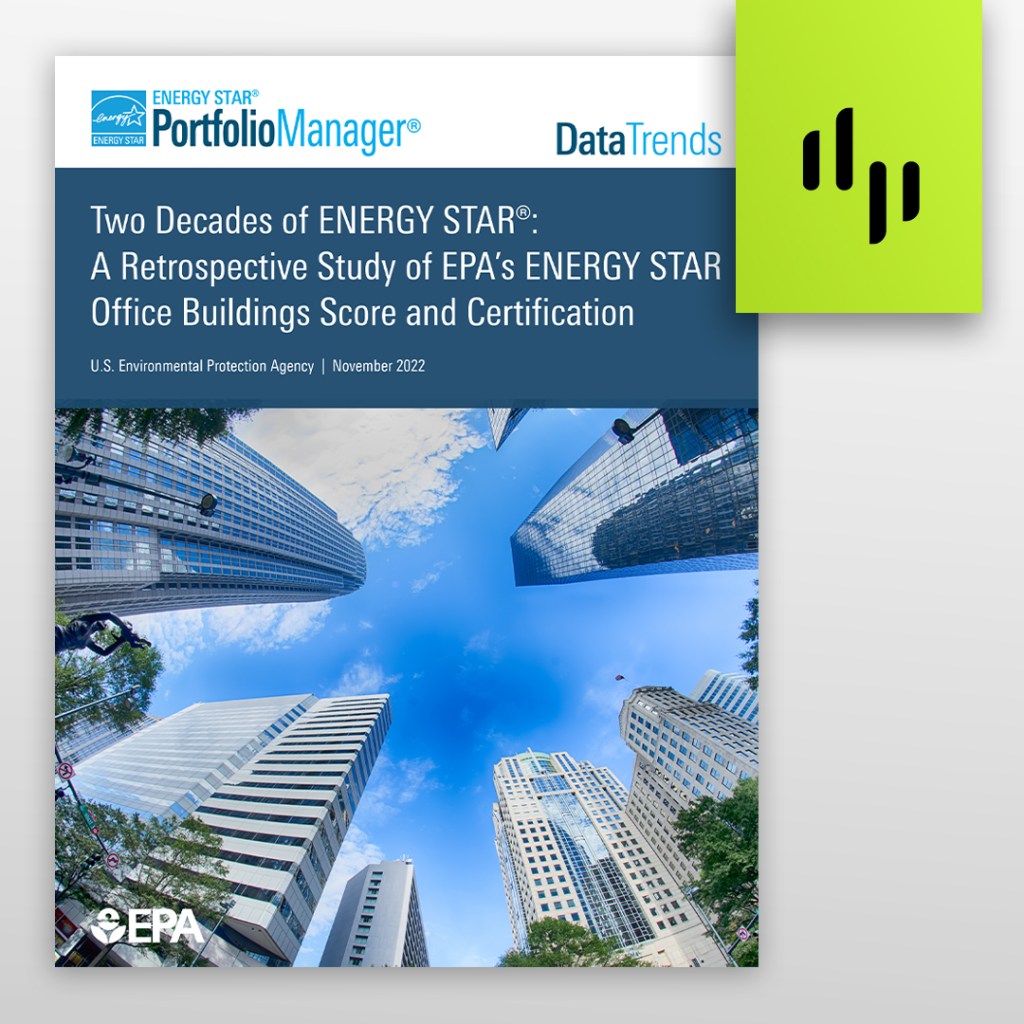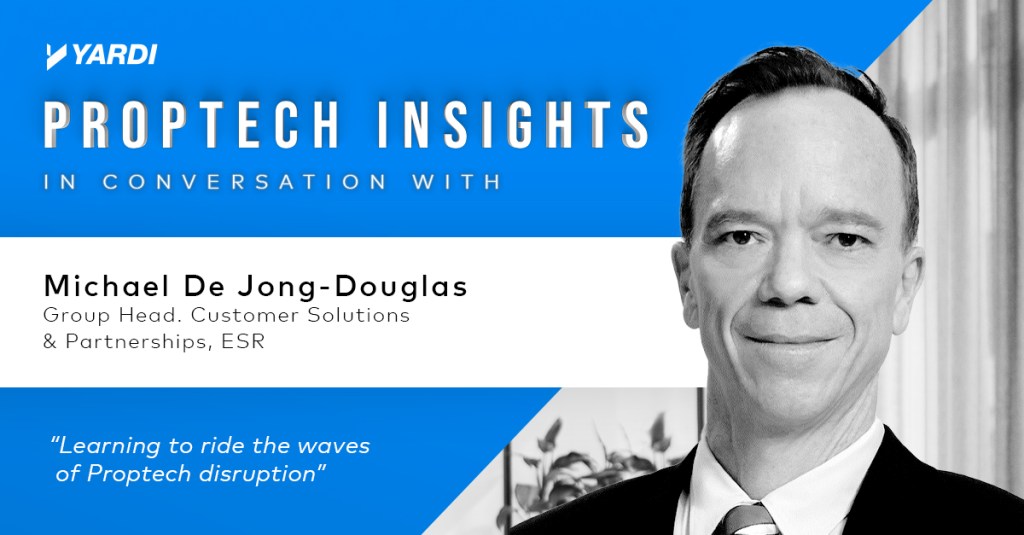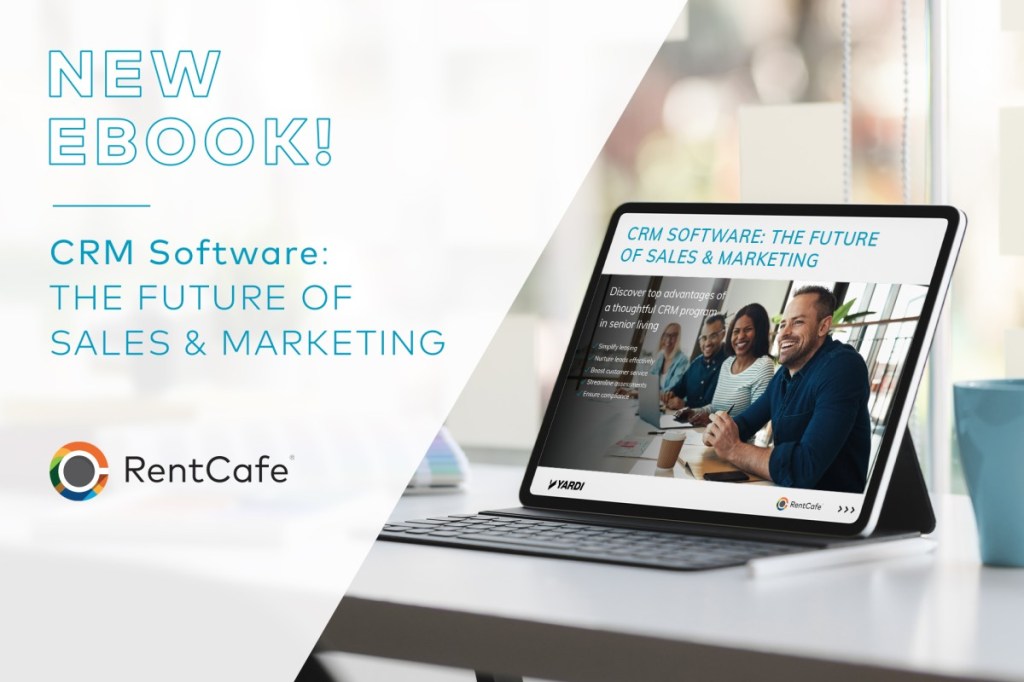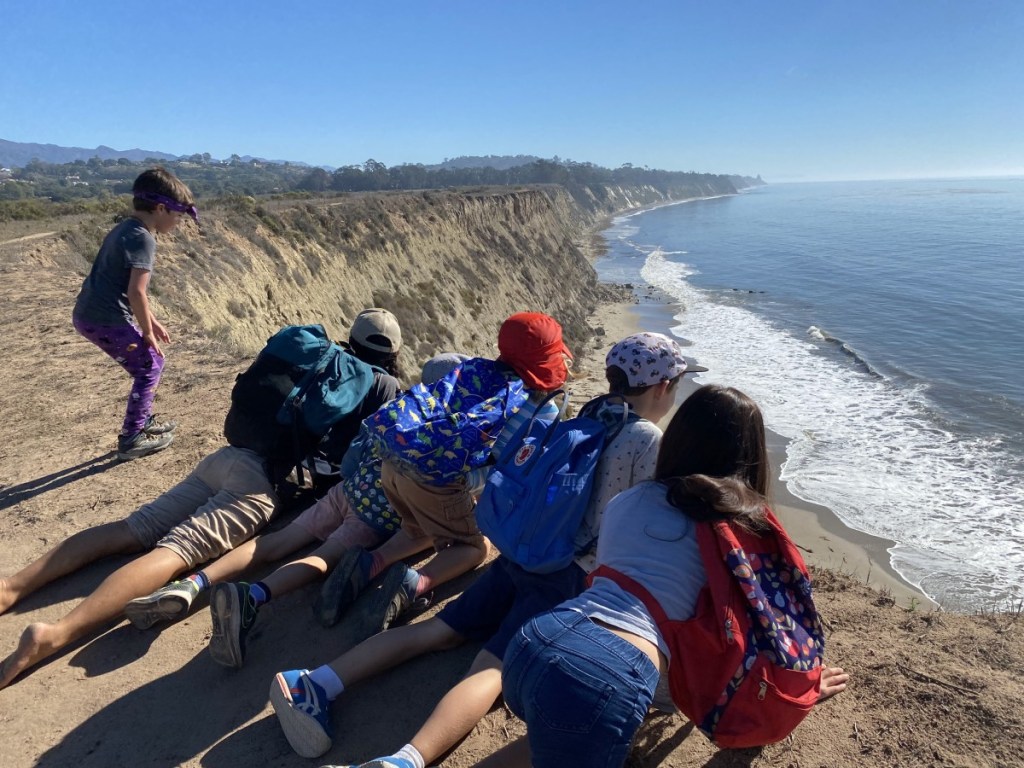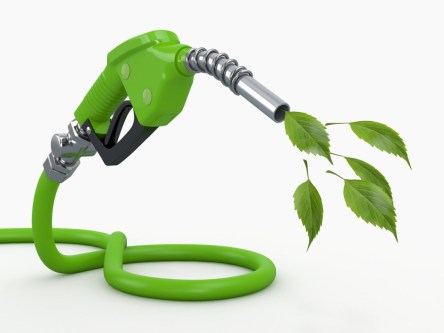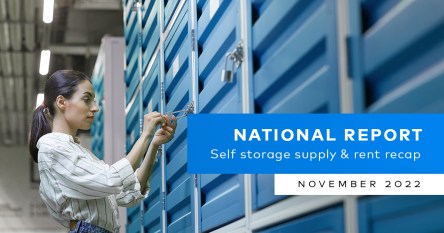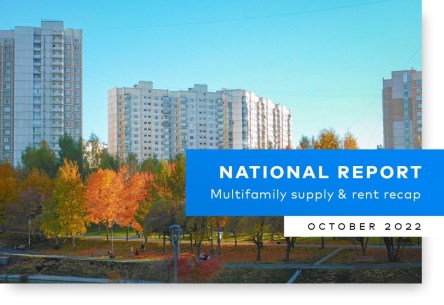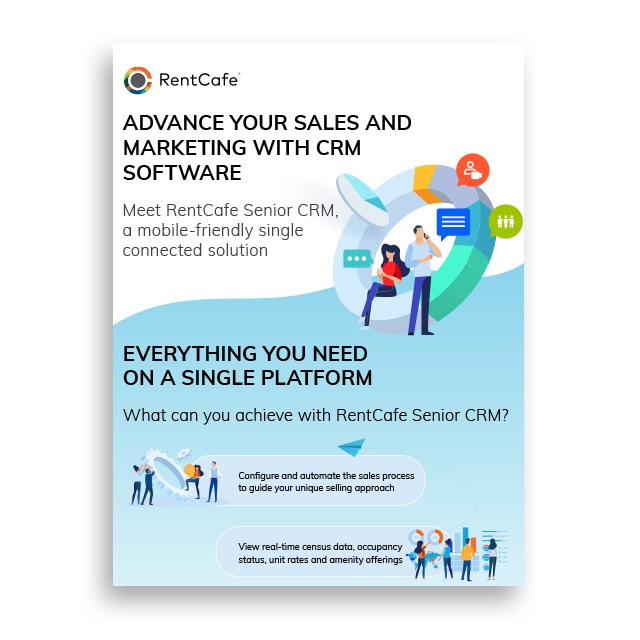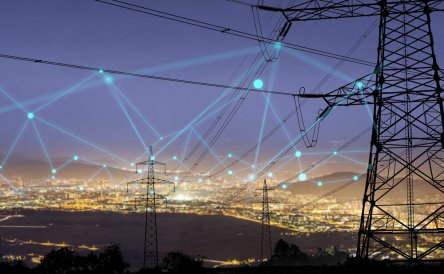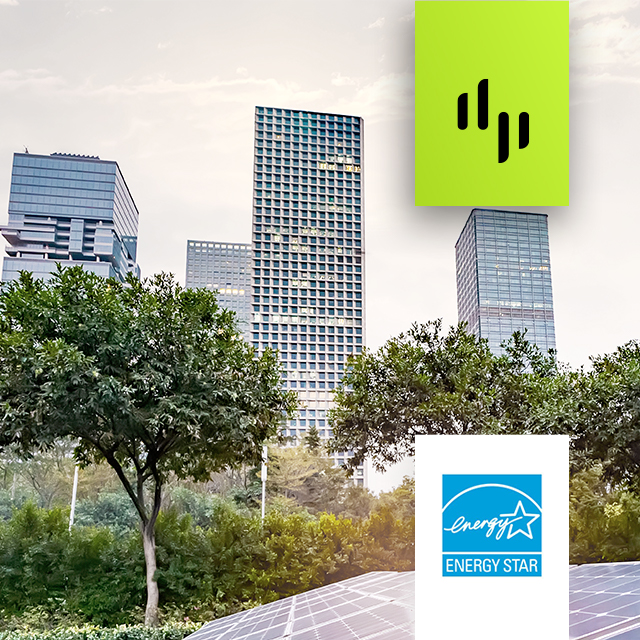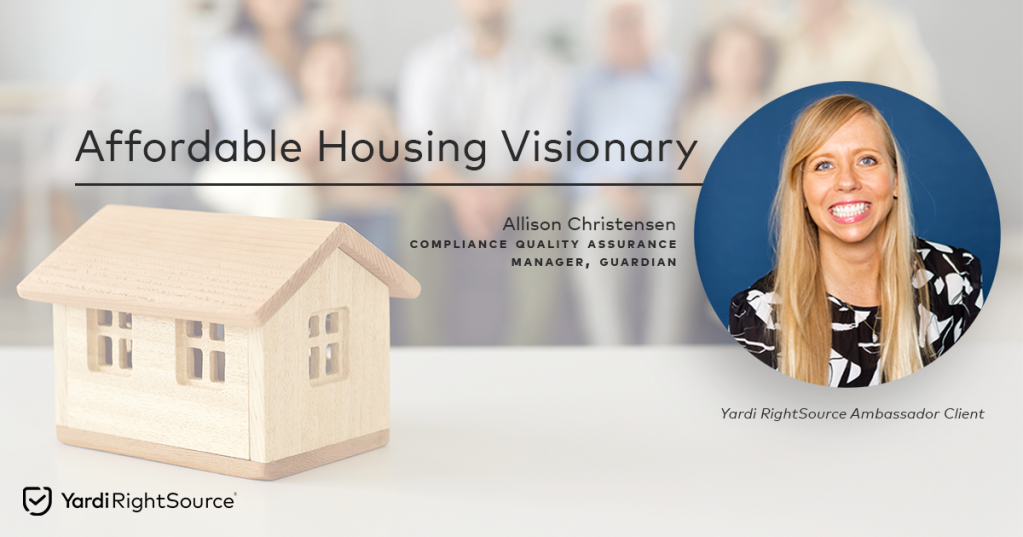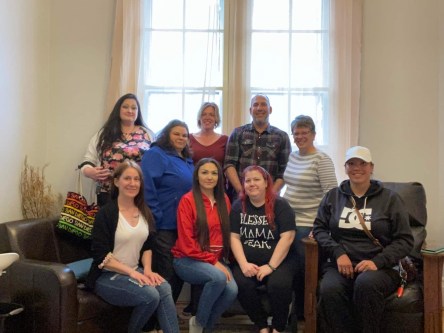A recent report from the U.S. Environmental Protection Agency traces 20 years of energy efficiency progress enabled by ENERGY STAR® and proposes a framework for achieving a zero-carbon economy. ENERGY STAR originated in 1991 as part of the EPA’s Climate Partnerships Programs initiative, which sought ways to reduce greenhouse gas emissions, promote carbon pollution-free electricity and achieve net-zero emissions targets. ENERGY STAR certifies businesses and consumer products that conform with energy-efficient solutions that protect the climate and public health. Documenting ENERGY STAR’s impact The EPA report notes that energy benchmarking enabled by ENERGY STAR® Portfolio Manager® has grown from 2,000 office buildings initially to more than 280,000 buildings encompassing over 27 billion square feet of space across 15 building types. More than 36,000 buildings – including the Yardi headquarters buildings in Santa Barbara, Calif. – have earned ENERGY STAR certification for excellence in energy performance. Key findings in the new report, which includes survey findings from 2019, include: ENERGY STAR-certified offices are 18 times larger than similar buildings, representing an opportunity to expand certification to smaller and mid-sized buildings. EPA incentives plus expanded state and local benchmarking, performance and disclosure mandates are expected to expand certification among smaller buildings Almost 40% of ENERGY STAR office buildings are all-electric, up from 30% in 1999. The report notes that efficiency of fuel use, rather than the mix of fuels used, drives ENERGY STAR-level performance. Furthermore, efficiently using electricity to meet energy needs positions buildings to leverage onsite renewable systems HVAC and lighting system upgrades are a priority, with 72% of ENERGY STAR buildings pursuing HVAC enhancements and 83% implementing lighting systems upgrades. Such upgrades were a priority for only about a third of the buildings reported in a 2012 survey ENERGY STAR buildings deploy more sophisticated...
Real Estate and EVs
Proptech Insights
Electric vehicles are heading towards real estate at speed and scale. With up to 300 million EVs on the roads by 2030, new business models are beginning to emerge. But for all the opportunities, there are also plenty of obstacles. Yardi’s Bernie Devine and ESR’s Dr. Michael De Jong-Douglas recently sat down to explore the possibilities. Dr. De Jong-Douglas, ESR’s Group Head of Customer Solutions & Partnerships, was the special guest on Yardi’s Proptech Insights, hosted by Bernie Devine, Senior Regional Director at Yardi. The International Energy Agency predicts that the number of electric vehicles on the roads – cars, vans, trucks, and buses – could reach 300 million by 2030. Last year electric car sales took off, surpassing the 6.6 million mark despite supply chain bottlenecks and the ongoing challenges of Covid-19. This took the total number of electric cars on the road to 16.5 million. The passenger vehicle market may be driving towards electrification at a rapid rate, but logistics vehicles – especially trucks travelling longer distances – are an entirely different proposition, the pair noted. But many of the world’s largest logistics companies have made commitments to electrify their fleets. Dr. De Jong-Douglas pointed to several 2030 commitments – DHL’s 60% global EV target, DB Schenker’s “emissions free” European footprint, Amazon’s plan for 10,000 EV vans in Europe and Unilever’s switch to EVs to cut their greenhouse gas emissions by 40-50% among them. Meanwhile, nascent, regional logistics players across Asia Pacific have begun EV initiatives in various markets. These include Linfox, Coupang, Sagawa, Maersk, and JD.com. As Dr. De Jong-Douglas suggested, these illustrate “very real examples of companies in our own backyard doing pilot projects and making very strong public commitments to switch to EVs.” While the market is on the move, there are clear challenges ahead. For example, the issue of range anxiety is easier to overcome in denser urban environments than in geographically dispersed economies like Australia, Devine noted. The uptake of EVs also varies across the region depending on the combination of “carrots” – incentives and subsidies – and “sticks” of regulation. For real estate companies, a “chicken-and-egg” scenario has emerged. How do they decide when, and to what extent, to provide EV charging facilities in their sites, for both passenger cars and delivery trucks? The challenge for asset owners is to roll out charging technology for customers today without getting “caught in one model” that compromises the opportunities tomorrow, Dr. De Jong-Douglas noted. Certainly, the “interconnectivity” of energy efficient buildings, renewable energy and EV charging were emerging as a “combined package” for any customer focused on ESG and “circular” solutions. But are fast, reliable charging stations the best solution? Or, Devine asked, could battery swaps become a thing? Are there other technologies ahead on the horizon? Conveniently located charging stations that allow vehicles to ‘top up’ their charge many times throughout the day make sense for smaller delivery vehicles, the pair agreed. Shell has already begun reimagining its fuelling stations as “energy hubs” with the provision of coffee, snacks and communal areas to provide pleasant places for customers to relax while their EVs recharge. ESR is in conversations with its customers “every single day.”, Dr. De Jong-Douglas added, “and our customers are saying to us: We are doing pilot projects, so get ready.” Check out the latest episode of Yardi’s Proptech Insights series or register for our next...
Advance your sales & marketing
New senior living ebook
Did you know more than 54 million adults ages 65 and older live in the United States — roughly 16.5% of the total U.S. population? And by 2050, that number is projected to rise to an estimated 85.7 million — roughly 20% of the U.S. population? As the aging population continues to grow, more will be searching for adequate housing opportunities to fit their needs — from active adult to independent to assisted living, all the way to memory care. That means senior living operators will require effective methods to attract prospects, nurture leads and retain residents as demand grows and competition heightens. Customer relationship management (CRM) software is the answer of today and tomorrow, and we created a fresh ebook to illustrate that. We’re excited to share this one! Explore the highlight below then read the ebook in full (spoiler alert, you’ll discover how RentCafe Senior CRM stands out from the crowd). New ebook explores CRM software By capturing and centralizing the data you need, an integrated CRM system accelerates sales and ensures a seamless prospect-to-resident journey. More specifically, the right solution helps operators: Simplify leasing Nurture leads effectively Boost customer service Streamline assessments Ensure compliance The ebook details each of these, sharing exactly how CRM software works to help your communities reach new heights. You’ll also see what makes RentCafe Senior CRM (Yardi’s integrated CRM solution) a differentiator. Want a preview? RentCafe Senior CRM is: Single stack Mobile-friendly HIPAA and SOX compliant Continuously evolving Guided by client feedback Also — unlike other CRM systems — RentCafe Senior CRM doesn’t require you to pay per user. You can add as many users as you’d like, from sales staff to caregivers, for one fixed cost. Same goes for our secure online portal, RentCafe Senior Living. Read the ebook in full We hope you enjoy the ebook (CRM Software: The Future of Sales & Marketing). If you’re ready for more info on RentCafe Senior CRM, our team would love to be your guide! Visit page 10 of the ebook and select “book a personalized demo” to get...
Wilderness Youth Project
The Nurture of Nature
Yardi is committed to supporting the community in every city where our offices are housed. Each year, the company distributes philanthropic aid to organizations selected by its employees. In 2021, Yardi offices supported more than 350 nonprofits worldwide. For the remainder of 2022, we will be bringing you the stories of those organizations and insight into how they aid their communities. Today we introduce you to the Wilderness Youth Project (WYP), a Yardi-supported nonprofit that was founded in 1999 in Santa Barbara, Calif. WYP connects children to nature in small groups guided by inspired, skilled, and committed mentors and volunteers. WYP envisions teaching the next generation of children to be peaceful, respectful, and confident stewards of the world. “Nature connection makes life better for kids,” shares Chandler McLane, donor relations manager for WYP. “Time in nature makes kids happier, healthier, and smarter.” At WYP children play, learn, and grow in Santa Barbara’s natural beauty. They get to have adventures and explore the outdoors for more green time, not screen time. Children gain confidence, a heart for adventure, and care for others. Having these types of experiences will help children grow up healthy and happy. WYP is planning to expand its fully subsidized Bridge to Nature program to more schools and community centers during the school year. The Bridge to Nature program serves the community and meets participants where they already are so they do not need to find transportation to WYP. Going outdoors is one of the best ways to keep children excited about learning and to build their connection with the natural world. “Our Bridge to Nature program exists as a way to bring WYP to locations that have more limited nature access at no cost to participants,” said McLane. Yardi has been in support of WYP since 2005. Funding from Yardi has helped WYP with its Bridge to Nature program by allowing them to purchase a new van. “Because of this, we will be able to take more children out to nature-rich locations all over Goleta, Santa Barbara, and Carpinteria” shared McLane. WYP also plans to acquire two new vehicles in the year to come, that will help fulfill the vision of providing WYP programs to local youth across the demographic spectrum. Nico’s story Nico started WYP when he was four years old. His mother recalls calling the office and crying tears of joy at the possibility of a scholarship, which made his participation possible. As a child with developmental delays, Nico struggled with social interactions and the ability to balance input and stimulation. His early experience with Wilderness Youth Project, though, was the first time Nico was appreciated for who he was and not for all his deficiencies. WYP saw the bigger picture of who Nico was and respected his personality and the gifts he had to offer to the rest of the group. At age five, Nico was diagnosed with autism and ADHD. During that time, he was challenged with perseverating and getting stuck on concepts. With a one-on-one aide, he continued participating in a Wilderness Youth Project after-school program where WYP mentors channeled his challenges into productive energy. With time, Nico developed a connection to nature, as well as a connection with others. Through his regular time in nature with a WYP mentor, all of Nico’s deficiencies were built upon with intentional guiding and nurturing. Nico’s mom remembers one of the best phone calls she ever got from a WYP staff member. After Nico had been going to WYP with a one-on-one aide for years, a WYP mentor called to ask her if she would be open to having Nico come to the program without an aide. “She was in awe of the training and the heart our staff had to integrate all of what Nico was into our programs without additional support,” shared McLane. “WYP has a way of honoring the sense of...
CALM
Supporting SB Families
Yardi is committed to supporting the community in every city where our offices are housed. Each year, the company distributes philanthropic aid to organizations selected by its employees. In 2021, Yardi offices supported more than 350 nonprofits worldwide. Today we introduce you to CALM, a Yardi-supported nonprofit founded in 1970 in Santa Barbara, Calif. In 1969, Claire Miles, a local nurse, learned that an overworked and emotionally stressed father had shaken his infant son to death in a moment of desperation. Claire took immediate action, put a phone in her living room, then took out classified ads in the local paper urging parents in need to call for help. The phone rang almost 40 times that first month. She and her friends took turns answering the calls, with the hope of helping stressed parents before a catastrophe occurred. From there, the organization grew quickly and has led the nonprofit community to adopt evidence-based treatment and prevention practices, using assessment and data to evaluate the effectiveness and continually improve its work. A positive family atmosphere is crucial for children to grow up in. CALM’s mission is to prevent childhood trauma, heal children and families, and build resilient communities throughout Santa Barbara County. CALM’s services are divided into four departments: Early Childhood Prevention and Intervention Childhood Trauma Treatment Intensive Family Services Community Strengthening Collaborations Services include individual therapy, home visitation, parenting classes, postpartum support, group therapy support and mental health consultation in school-based settings. “Some common issues we treat are domestic violence, neglect, anxiety, and depression often a combination of these,” said Ashlyn McCague, Director of Development for CALM. “Every client is unique, and each situation involves a custom treatment plan to address goals related to behavior, mental health, and building positive relationships.” Funding from Yardi...
Tune In
Can Radio Stay Relevant?
Radio was once a premier source of information and entertainment. Starting in 1920 with the world’s first commercial radio station in Pittsburgh, the medium grew to more than 44,000 stations worldwide 100 years later and reached 70% of the world’s population by 2016, according to the United Nations. “From its conception, radio has had a profound impact on society. It is the vehicle that brought, and still brings, music from one culture to another, creating a curiosity for diversity and opportunities for so many less privileged artists. The connectivity and community support radio offers is incredible and consistent, even though how we do radio is ever-changing,” says Jared Thompson, vice president of content for Blinder, an Auckland, New Zealand, communications and media tech firm. Radio can provide a rallying point during pandemics, moments of national turmoil and natural disasters and as a vital source of news as local newspapers decline. In fact, a radio station’s strongest asset is its connection to a community, says Donna Halper, an associate professor of communication and media studies at Lesley University: “Successful stations have relatable personalities who are plugged into the community. [They] are live and local as much as possible.” But radio is facing some stark challenges. Digital and on-demand formats, televisions, smartphones, tablets and computers have largely superseded it as a medium of choice. Platforms such as Spotify and Pandora give consumers access to the songs they want, with no commercials. Larry Miller, head of New York University’s Steinhart Music Business Program, reported in 2017 that AM/FM radio was less influential than YouTube, Spotify and Pandora as a source of music discovery among music fans 12 to 24 years old. Online listening continues to grow in almost every age demographic. Most new cars are connected to...
Fuel for Thought
Non-Petroleum Options
Amid spiking gasoline prices and concerns over global warming, are cleaner fuel sources available? Yes, says HotCars, a Canadian information source for the car, pickup truck and motorcycle industries: “The number of alternative fuels out there is surprising, and it speaks volumes to the innovation of people the world over. Some of them may even become mainstream in the future.” Here’s a rundown of some alternative fuels in production or development: Hydrogen Hydrogen fuel can be used in both hydrogen fuel cells and in internal combustion engines. It’s a zero-carbon emissions fuel if the process that creates the hydrogen is also zero carbon, such as wind or solar. A hydrogen fuel cell electric vehicle uses a fuel cell instead of a battery to power a car. It can be extracted from a variety of sources. Their driving range is similar to internal combustion engines. Eighteen thousand fuel cell electric vehicles had been leased or sold by the end of 2019, with those cars traveling an average range of between 314 and 380 miles between refuelings, according to British engineering, materials and joining technologies advocacy organization TWI. “To be a truly viable option, many of the challenges around hydrogen storage, transport and extraction will need to be addressed,” TWI says. Also, a hydrogen refueling infrastructure doesn’t exist in most of the country. But, says the Environmental and Energy Study Institute, a Washington, D.C.-based nonprofit that promotes sustainable practices, “the higher cost of hydrogen on an energy equivalent basis is outweighed by the greatly increased efficiency of the electric drive system relative to the internal combustion engine.” Propane Propane vehicles operate much like gasoline vehicles with spark-ignited internal combustion engines. The fuel is commonly used in vehicles such as forklifts, skid steers, transit buses and recreational...
Yardi Matrix Multifamily Webinar
Sector outlook, anticipated recession and more
Yardi Matrix experts Jeff Adler and Paul Fiorilla presented their final 2022 outlook for the multifamily sector during a Nov. 16 webinar. As with most current economic forecasts, it’s a challenging picture despite recent record-setting performance and consistently strong fundamentals. The presentation materials and webinar recording are now available for download. According to the latest National Multifamily Report, average multifamily asking rents showed a slight increase in October, despite weaker demand and dipping year-over-year (YOY) growth. “The pandemic recovery has been rapid, it has been V-shaped, but now it is indeed cooling. We’re really on the downturn, is what I would tell you. The U.S. economy is slowing, the yield curve has inverted for all intents and purposes,” said Adler, vice president of Yardi Matrix. “When it comes to the U.S. multifamily industry, the domestic migration has had a significant impact on demand, but household formations have had even a larger impact,” Adler said. Demographic trends are expected to support continued housing demand. Rising interest rates, however, will preclude many would-be buyers from home purchases in the near future. First-time homebuyers are being frozen out of the market, according to the National Association of Realtors, and will be more likely to remain in rentals. “The capital markets are really what’s the problem, mortgage rates are up to 6 percent and above, and valuations have adjusted downward,” said Adler, off as much as 25 percent from a peak in January 2022. However, U.S. multifamily continues to be a standout sector among all asset types. “Declining homeownership will be a bit of a tailwind (for multifamily),” as long as household formation holds up, Adler said. “Fundamentals have been great, but they are decelerating.” U.S. asking rents increased $3 in October to $1,727. Year-over-year growth fell to 8.2 percent, the lowest level since the summer of 2021 and down from its 15.3 percent peak in the first quarter. The single-family rental market is also cooling off. The average U.S. asking rent was unchanged at $2,088 in October, while the YOY increase fell by 160 basis points to 6.6 percent. “SFR/BTR fundamentals are strong, but they’re also decelerating, very similar to multifamily,” Adler said. And with a difficult construction financing environment, limited new supply is expected through 2026. This could exacerbate the U.S. housing supply shortage, pushing it out through the next decade. As far as an anticipated recession, that’s currently very likely by the fourth quarter of 2023, according to experts. “Essentially we’re on a glide path to the next recession, which is probably one of the most well forecasted recessions I’ve seen in a while,” Adler observed. Learn more about Yardi Matrix’ wide variety of commercial real estate reports and...
CASA of SB County ...
Advocating for Kids
Yardi is committed to supporting the community in every city where our offices are housed. Each year, the company distributes philanthropic aid to organizations selected by its employees. In 2021, Yardi offices supported more than 350 nonprofits worldwide. For the remainder of the year, we will be bringing you the stories of those organizations and insight into how they aid their communities. Today, meet the Court Appointed Special Advocates (CASA) of Santa Barbara County. Founded in 1993, 2023 will mark a significant milestone for CASA as they begin their 30th year of advocacy for children in the foster care system. The CASA program recruits, screens, and trains community volunteers sworn in by the country to advocate for a child who has experienced abuse and neglect. “Once assigned to a child’s case, our professional team of Advocate Supervisors engages, empowers, and guides our CASA volunteers with training, case management, supervision, technical assistance, and support as they advocate for our community’s most vulnerable children,” shares Crystal Sullins, donor relations and grants manager for CASA. CASA is the only nonprofit organization that exclusively advocates for children while in the protective care of the court. When a child enters the court system due to abuse or neglect, a judge appoints a CASA volunteer to advocate on the child’s behalf. “No child should have to navigate the foster care system alone, so having a highly trained CASA volunteer by their side empowers children and gives them a voice in court,” said Sullins. Donations from Yardi help ensure that CASA can continue recruiting, training, supervising, and supporting the volunteers needed to maintain CASA operations and help build program capacity to serve every child. The CASA program is nationally recognized as a powerful tool for improving positive outcomes for children in...
Self Storage Update
From Yardi Matrix
National self storage street rates hit their lowest average of the year last month, according to the latest National Self Storage Report from Yardi Matrix. Average street rates for both 10X10 climate controlled (CC) and 10X10 non-climate controlled (NON-CC) units slipped in October for the second straight month as demand weakened. The national average rate in October was $145, the lowest in 2022 so far. The figure is a 0.7 percent decrease year-over-year (YOY). “Home sales, a major driver of storage demand, have slowed sharply in recent months as rising mortgage rates have made homebuying less affordable,” states the report. “What’s more, as inflation persists and a recession is increasingly likely, households are cutting expenditures on non-essential items such as storage.” Many operators are reducing street rates to maintain high levels of occupancy and looking for ways to cut costs in the event of an anticipated recession. Some operators are moving to remote facility management to reduce site staff and cut operating costs. For NON-CC units, only one of the top 31 Matrix-tracked metros had an annual street rate increase greater than five percent in October, while rates decreased in 11 of the top metros. For CC units, just one of the top 31 had five percent or more growth, while 21 metros registered negative rate growth YOY. Learn more about the state of the self storage market nationwide. Yardi Matrix tracks a total of 4,458 self storage properties nationwide in various stages of development — including 1,711 planned, 800 under construction and 604 prospective properties. Matrix also maintains operational profiles for 28,847 completed self storage facilities across the United States, bringing the total data set to 33,305. Yardi Matrix offers the industry’s most comprehensive market intelligence tool for investment professionals, equity investors, lenders and...
Domestic Violence Solutions
For Santa Barbara
Yardi is committed to supporting the community in every city where our offices are housed. Each year, the company distributes philanthropic aid to organizations selected by its employees. In 2021, Yardi offices supported more than 350 nonprofits worldwide. For the remainder of the year, we will be bringing you the stories of those organizations and insight into how they aid their communities. In today’s spotlight, Domestic Violence Solutions for Santa Barbara County (DVS), a Yardi-supported nonprofit, was founded in 1977. The organization provides safety, shelter, and support for individuals and families affected by domestic violence and collaborate with community partners to raise awareness regarding the cause, prevalence, and impact. DVS is the only service provider for those affected by domestic violence in Santa Barbara County, which would not be possible without the support of the community. “As a society, we all have a role in changing the narrative about what domestic violence is, to whom it happens, and how we can support those who are experiencing it, and, ultimately, prevent it entirely,” says Tina Ballue, Director of Development for DVS. “To be able to support survivors, and to prevent domestic violence in the future, we all need to normalize talking about it openly and candidly.” DVS’s goals for the year to come include expanding reach through more multicultural and multi-lingual service provisions, seeking out new transitional and permanent housing opportunities throughout the county, and maximizing federal and state resources to assist clients. Funding from Yardi is helping DVS to build the capacity to be able to help more clients. In addition, building a volunteer program that will allow DVS to be more present in the community to increase awareness and provide preventative education to end domestic violence. “Our ultimate goal is to have a future free from domestic violence, this can only happen with the support from community leaders such as Yardi,” shared Ballue. 24-hour assistance available DVS has a 24-hour support hotline which has been an asset to many of its clients. One mother was especially grateful for it and Domestic Violence Solutions. “DVS gave me the tools to fight and be a survivor to stand strong and confront the situation with authority and confidence. They helped me with my self-esteem. I got to meet new friends that supported each other through the transition,” the survivor stated. “Thanks to DVS, I now have an apartment I can afford and feel safe with my children, our car, and a great job. My son will graduate in June, and he is safe now. My daughter sees a strong mother who will do everything she can for her children.” She spoke about how the support she received has changed her outlook on herself and on the need for resources like DVS. “I’m not ashamed anymore. I feel worthy and willing to receive help. Not only do they help in what they can, but they also place their lives in danger for us. I’m very grateful and blessed to have been a client. I thank God for generous the support of people like you to help and support DVS, allowing them to continue their mission of saving lives and keeping them safe.” Volunteer Opportunities “We need to change the conversation around domestic violence – and we need your help to do it,” shared Ballue. Domestic Violence Solutions is working to rebuild its volunteer program post-COVID-19 pandemic and begin training help to expand services. There are many unique opportunities available at DVS. From volunteering with clients to organizational committees such as events and outreach. For more information, please visit their website here. Find future non-profit profiles at...
Multifamily Update
From Yardi Matrix
Average multifamily asking rents showed a slight increase in October, despite weaker demand and dipping year-over-year (YOY) growth, according to the latest Yardi® Matrix National Multifamily Report. U.S. asking rents increased $3 in October to $1,727. Year-over-year growth fell to 8.2 percent, the lowest level since the summer of 2021 and down from its 15.3 percent peak in the first quarter. The single-family rental market is also cooling from record-level performance. The average U.S. asking rent was unchanged at $2,088 in October, while the YOY increase fell by 160 basis points to 6.6 percent. The deceleration in asking rents is gradual, as all of the Matrix top 30 metros produced YOY rent increases. Experts are concerned about how the multifamily market will react to the rapid increase in short-term interest rates as the Federal Reserve attempts to reduce inflation. “The inevitable economic slowdown raises questions about when the impact will start to be felt and how much the sector will be affected,” states the report. “Demand has weakened since the first quarter due to slowing job growth and concerns over the macroeconomic environment. The robust household formation that drove demand in 2021 is no longer in effect.” The U.S. rental occupancy rate has dropped 50 basis points over the past year, but the national 95.5 percent rate remains above the long-term average. With debt costs higher and still rising, property sales and new construction have begun to slow. However, with home mortgage rates up to 7.3 percent as of early November, first-time homebuyers are being frozen out of the market, according to the National Association of Realtors, and will be more likely to remain in rentals. Learn more in the latest Matrix National Multifamily Report. Yardi Matrix offers the industry’s most comprehensive market intelligence tool...
RentCafe Senior CRM
Advance Sales + Marketing
Ready to advance your sales and marketing? Meet RentCafe Senior CRM, our mobile-friendly single connected solution. To paint the picture of how this solution helps senior living operators — and their sales teams — reach new heights, we put together a brand-new infographic. We hope you enjoy learning all about RentCafe Senior CRM and the benefits it brings: Did you know 65% of sales professionals use CRM, and 97% consider sales technology to be important or very important? And out of companies using mobile CRM, 65% achieved sales quota compared to 22% of those without mobile CRM? Everything you need on a single platform As the infographic shares, RentCafe Senior CRM allows you to: Configure and automate the sales process to guide your unique selling approach View real-time census data, occupancy status, unit rates and amenity offerings Eliminate duplicate data entry with a united leasing and move-in workflow Lead with confidence using a platform integrated with multiple elements of the Yardi Senior Living Suite Generate, complete and upload documents to RentCafe Senior Living, where residents and family members can sign electronically Reduce risks with a solution that is HIPAA and SOX compliant Access visual reporting with configurable, group-based dashboards and a wide selection of KPIs Drive efficiency with a convenient mobile app built for iOS and Android devices Enjoy the convenience of Yardi as your single support avenue Evolving functionality designed for senior living What makes RentCafe Senior CRM a differentiator? At a glance, this mobile-friendly system offers: Inbound and outbound calling, texting and emailing Duration and engagement tracking Triggered activity follow up Predictive analytics Automated prospect and referral correspondence Event management Third party API integrations Lead scoring Level up with RentCafe Senior CRM Curious what else RentCafe Senior CRM can do? Read the...
Building Energy
ARPA-E Project Updates
The Advanced Research Projects Agency-Energy (ARPA-E) sponsors corporate and academic institutions in a variety of energy-related projects. Here’s the latest of our periodic reviews of recent developments at the agency, which serves as the U.S. Department of Energy’s R&D arm. Buildings as carbon storage facilities In June, the DOE announced 18 contract awards for its Harnessing Emissions into Structures Taking Inputs from the Atmosphere (HESTIA) program, which aims to develop technologies that can transform buildings into net carbon storage structures – meaning they absorb more carbon from the atmosphere than is released during construction. The HESTIA projects “will develop and demonstrate building materials and whole-building designs from a wide range of potential feedstocks (e.g., forestry and purpose-grown products, agricultural residues, direct carbon utilization) that are net carbon negative on a life-cycle basis by using atmospheric CO2 in the production process,” according to ARPA-E. “This is a unique opportunity for researchers to advance clean energy materials to tackle one of the hardest to decarbonize sectors that is responsible for roughly 10% of total annual emissions in the United States,” Energy Secretary Jennifer M. Granholm said in a press release. HESTIA project team members receiving contracts include the National Renewable Energy Lab in Fairbanks, Alaska; Purdue University; Aspen Products Group of Marlborough, Mass; Biomason, based in Durham, N.C.; and the University of Pennsylvania. Another HESTIA project, announced in March, awarded contracts to the University of Washington and UC Davis to evaluate materials and designs and generate lifecycle assessments for the project. Learn more about the HESTIA projects. Forward-thinking tech projects net funding Twenty small businesses received contracts in July under ARPA-E’s Supporting Entrepreneurial Energy Discoveries (SEED) program, which seeks to develop forward-thinking energy technologies ranging from revamped biofuel manufacturing, newly efficient extraction of metals from e-waste, sustainable...
EPA Buildings Report
Highlights Disparities
A report from the U.S. Environmental Protection Agency illustrates how race and income impact the energy performance of a community’s buildings. The DataTrends research and analysis report shows that ENERGY STAR® scores for buildings in communities of color averaged 2% lower than buildings in majority-white communities. Buildings in low-income communities scored an average of 4% lower than moderate- and high-income community buildings. The EPA report, which summarizes ENERGY STAR® Portfolio Manager® data and ENERGY STAR scores from 242,098 buildings spanning 85 building types, found that: The average ENERGY STAR score – a 1-to-100 rating that compares a building’s energy performance to similar buildings nationwide – in communities of color was 57.5 vs. 58.8 for buildings in majority-white communities ENERGY STAR scores in buildings in low-income communities averaged 56.5 vs. 58.8 recorded in moderate to high income communities K-12 schools and multifamily buildings show the largest differences in average ENERGY STAR scores as measured by both race and income level The proportion of fully electrified buildings in cold and moderate climates was 15.2% for communities of color and 20.6% for majority-white communities. The prevalence of electrification in similar low-income communities was 15.3% vs. 20% in moderate- and high- income communities 9.1% of buildings in communities of color in moderate and cold climates are reliant on heating oil – which has the highest carbon emissions intensity among the most common fossil fuel heating sources – whereas only 5.8% of white-majority community buildings are. The gap is narrower between low-income communities and moderate- to high-income communities: 6.5% and 6.8%, respectively The proportion of buildings equipped with onsite solar energy is virtually the same in all racial and income strata – 1% for communities of color and 0.8% for white-majority communities, 0.8% for low-income communities and 0.9% for...
Reimagining Affordable
Guardian Discusses Compliance
What does it mean to reimagine affordable housing? Who are the affordable housing property managers and compliance professionals leading the way? How do Yardi solutions fit in? Stay tuned to The Balance Sheet over the coming months to read our new series highlighting the work and successes of who we are calling Affordable Housing Visionaries. Throughout the series, we’ll speak with affordable housing providers and learn how their use of evolving technology has helped them reimagine the future of affordable housing compliance. Guardian achieves measurable outcomes with outsourced compliance First in the series is Guardian, based in Portland, Oregon. Read on to learn how Guardian’s Compliance Quality Assurance Manager, Allison Christensen, is leading the organization’s embrace of outsourced affordable housing compliance expertise to build a stronger team and achieve measurable benefits. Q: Hi Allison! Please introduce us to Guardian. AC: Guardian is a developer, owner and operator of multifamily properties. We provide innovative real estate solutions dedicated to community and housing for all. We are based in the Pacific Northwest, and our customer-focused team is committed to supporting and lifting the communities we serve. Q: Describe an example of compliance technology that Guardian has implemented? AC: In July 2020, we began contracting with Yardi RightSource to review affordable housing applicant and recertification files for completeness and compliance with our funding sources. We’ve found that RightSource has helped Guardian expedite our file processing times, improved our data accuracy and leveraged data integrations for greater efficiency. Q: Tell us more about how data integration is valuable? AC: Yardi Voyager is our core operating platform for managing properties, finance and affordable housing compliance data. And, because RightSource auditors have seamless integration with Voyager, we are assured that our compliance data is always accurate and up to date. Q: How did Guardian adjust its team structure after adding RightSource compliance services? AC: It’s true that our staff assignments changed once we outsourced a portion of our compliance services. However, the process was done with care and consideration of all affected team members. Some of Guardian’s former compliance team members were reassigned within the company, and others even began working at RightSource. Everyone landed in a great space. RightSource was very helpful in ensuring staff assignment changes were handled with care. Q: Please describe Guardian’s compliance reporting processes? AC: One of the benefits of adopting new solutions is the ability to simplify processes which, in the past, may have been particularly stressful on staff resources. We’ve found that adding RightSource simplifies reporting because of how data is shared between auditors and Yardi Voyager. As part of the audit process, RightSource team members ensure compliance data is accurate while connected to the core Voyager database. That reduced chances for errors or misplaced data due to extraneous data transfers. So, when it’s time for Guardian to compile data for compliance reporting, we feel assured our reports are accurate and reflective of everything our properties have achieved. Q: How does training fit in with reimagining affordable housing? AC: The complexities of affordable housing are real, and training has always been a core component of successful strategies. We provide our employees with self-paced instructional content that’s available online. We’ve found this type of training resource is more effective than what the industry had traditionally relied on. RightSource makes the content available and updates it as compliance regulations evolve. It’s a great resource for new and current staff. Q: What is the central benefit Guardian has achieved by adopting new compliance technology? AC: Communication. Embracing outsourced compliance services keeps us well informed with everything happening with our new resident applications and current resident recertifications. We can log in any time to see exactly where all files are in the queue. For example, which applicant files are incomplete, which are pending review, which are coming up for recertification, and on and on. RightSource promises a 24-hour turnaround for file review, and...
New Milestone!
Yardi Pharmacy Network
You may have read our past blog posts on the Yardi Pharmacy Network, our growing market of pharmacies connected with senior living providers using Yardi eMAR. Excitingly, that market has just reached a new milestone. We’re happy to announce that Yardi now has 500+ communities with a live pharmacy interface! It’s a wonderful accomplishment that our senior living team is proud to share. See below for more details. Exploring the Yardi Pharmacy Network In case you’re unfamiliar with the Yardi Pharmacy Network, we’ll go over some key points. In essence, this dynamic network facilitates communication between point-of-care staff and pharmacies, resulting in a higher standard of medication administration. Yardi eMAR integrates with a variety of pharmacy interfaces including QS/1, FrameworkLTC, Omnicare, Computer-Rx, Prodigy, PharMerica and Suite RX. View our full list of current partners. In joining the Yardi Pharmacy Network, pharmacies gain a competitive edge with access to senior living providers who have adopted Yardi’s platform. For providers, that results in simplified operations, reduced costs with order management, seamless electronic refill requests and automated medication reconciliation. Yardi Pharmacy Network reaches new milestone To better illustrate why we’re excited about the 500+ (501, to be exact) communities milestone, here’s a breakdown of the numbers in prior years: 2019: 100 communities2020: 200 communities2021: 396 communities2022: 501 communities Each integration has several moving parts, so this growth is a testament to our wonderful team, senior living clients and the partnered pharmacies. Learn more about the Yardi Pharmacy Network in our brochure. Get in touch Thanks for reading all about our new milestone — we look forward to updating you as our growth continues. If you have any questions on the Yardi Pharmacy Network, don’t hesitate to get in...
BGC Saskatoon
Mental Health for Youth
Yardi is committed to supporting the community in every city where our offices are housed. Each year, the company distributes philanthropic aid to organizations selected by its employees. In 2021, Yardi offices supported more than 350 nonprofits worldwide. For the remainder of the year, we will be bringing you the stories of those organizations and insight into how they aid their communities. Today we journey north. BGC Saskatoon is a Canadian nonprofit, established in 1974 in Saskatoon, Saskatchewan, Canada. BGC’s primary focus is to provide a safe, supportive place where children and youth can experience new opportunities, overcome barriers, build positive relationships, and develop confidence and skills for life. BGC wants children and youth who might have a disadvantage, whether it is a lack of resources or family support, to have the chance to participate in traditional community programs. “Having a safe place to be where the kids are exposed to new opportunities and positive adult role models is very important in the development of children and youth,” shares Heidi Carl, Director of Operation at BGC. “We support children, youth, and parents through a parenting program and a mental health initiative that serves the entire organization.” BGC Saskatoon is focusing on the needs of children and their families for the year ahead. The pandemic increased demand for programs and services helping families to meet basic needs and professional mental health support. “As our communities are making efforts to return to a post-pandemic normal, needs have changed and become more critical, the cost of living has increased and the added stressors and pressures have increased mental health concerns,” says Carl. Funding from Yardi has helped BGC meet the needs of children and families in support of professional mental health. Funding helps BGC offer early interventions...
A Single Solution
For IM and ESG Efficiency
A growing need for transparency among real estate managers, tenants, regulators and investors is expanding the value of automated property management technology platforms that centralize operational and financial data. “You need a consistent process to allow investors to access timely information,” says Chris Barbier, senior director of investment management at Yardi. “The new generation of investors has an expectation to access data anytime, anywhere, on any device.” That’s true with environmental, social and governance issues as well. “Clients need to be able to report ESG data to investors and regulators. They want aggregated data that can be used for multiple purposes,” adds Joe Consolo, director of Yardi Energy. “Investors want access to their energy information on the same system as the investment data.” Real estate investment and energy consumption management systems capable of integrating all data are starting to supersede manual systems that rely on email, spreadsheets and other less-efficient tools, according to Barbier and Consolo, who offered their insights in an interview published in PERE magazine. Why adopt a platform that connects accounting, operations, investment activities and ancillary services? Because, Barbier says in the article, it produces a single source of the truth that encompasses “the underlying asset, rolls into whatever the investment structure is and then ultimately out to the investor, all in one ecosystem.” A similar rationale applies to ESG compliance, Consolo notes. Accurate assessments of energy consumption and greenhouse gas emissions are crucial to property owners’ ability to meet emissions targets, prompting many to seek technology platforms that consolidate governance documentation and measure energy, water and waste data in one system. Risk mitigation is the greatest value proposition for adopting a single connected solution for investment and environmental performance, Barbier and Consolo say. Such a platform enables decision-making informed by...
Mobile App Makeover
RentCafe Senior CRM
If you’ve been in our RentCafe Senior CRM mobile app lately, you likely noticed several exciting updates. Either way, we’re here to talk about what’s new — and improved — courtesy of our latest release! Each enhancement was powered by client feedback, which makes this release all the more fulfilling to share. Read the summary below to learn more about the updates, then download the RentCafe Senior CRM mobile app (if you haven’t already) to explore for yourself. Our mobile app makeover In a world where many of us use apps regularly, we know the importance of keeping things fresh and easy to navigate. That coupled with feedback from our amazing senior living clients drove the latest revamp of the RentCafe Senior CRM mobile app. At its core, this release completely freshened the app’s user interface. We’ve redesigned the dashboards, updated the prospect profile and more. This allows for easier navigation and task completion, which is critical for sales counselors with a busy schedule. Adding to the enhanced user interface, the refreshed mobile app now includes functionality with RentCafe Conversations, as well as the ability to see unit market rates. Here’s a list of all the primary functions within the app — easily accessible on the go. Users can: Add/review prospect records Monitor queue leads Activate/deactivate leads Create/complete activities Contact prospects via call, text or email (call/text requires RentCafe Conversations license) Add/review referrals Review units by status and market rates Review calendar Ready to see the app in action? Download the RentCafe Senior CRM mobile app on Google Play or the App Store. All about RentCafe Senior CRM RentCafe Senior CRM offers intuitive sales and marketing tools designed for senior living. Ready to strengthen lead management, enhance communication and ultimately maximize occupancy? This may...

